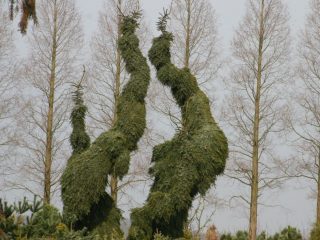Content
Various varieties of spruce are popular in Russia. With their help, parks, alleys, and gardens are beautified. Evergreen trees can be grown in a variety of ways. Spruce is usually propagated by cuttings. Depending on environmental conditions, other options are possible.
Peculiarities of spruce reproduction

Norway spruce gets along well in Russian, European and Western climates
Coniferous trees are classified as gymnosperms. This means that their seeds are located in an open form. In spruce trees they are found in scaly fruits. The cones are bisexual.
How spruce reproduces in nature
In common spruce, the reproductive organs are quite specific. They are called strobili and are modified branches. The branches collected in one bunch form cones. Male specimens appear first, and female specimens appear at the end of spring. The latter produce macrospores, which are concentrated in pollen sacs. They are located in the upper part of the tree, which ensures better reproduction in the wind.
Male fruits are called microstrobilae. They are more yellow in appearance and form on the sides of the plant. The spores have the same yellowish tint. Spruce releases pollen in the spring, pollinating female cones.
By autumn, female fruits grow to large sizes and become dark brown. Some varieties may have a different color - from green to black. With the onset of cold weather they ripen. Driven by northern winds, cones can end up several kilometers from the parent plant. This is a very effective method of reproduction.
In unfavorable conditions, the seeds “fall asleep” until the climate and moisture change for the better. This period may take more than 10 years. Next, the seeds germinate and take root deep into the soil. The young seedling will be protected by larger trees for some time. As he matures, he will begin to displace his old neighbors. This happens because spruce needs a lot of light. She doesn't get it in the shade of other plants.

Depending on external conditions, the conifer may look different
Flowering occurs approximately once every four years. To do this, the spruce must grow for at least 24 years. Some need much longer - up to 50 years. It all depends on the lighting level. Breeders have managed to speed up the reproduction processes of certain species. Thus, certain varieties can bloom as early as 12 years.
How to propagate spruce at home
Reproduction of spruce is possible in different ways. The tree is grown using cuttings, seeds or branches from the parent plant.
Sowing seeds
Reproduction using seeds takes longer than other methods. However, there are gardeners who like to watch the growth process. Before extracting the seeds, the ripe cone must be dried. She shouldn't be too young or old.Planting material is stratified and prepared for planting.
Sprouts need constant movement. At first they are especially vulnerable. The spruce may become sick or be attacked by pests.
Cuttings
Vegetative propagation of spruce is usually practiced. Cuttings do not require as much attention as planting from seeds. In addition, the spruce grows faster. Planting is carried out in the spring, when the buds are saturated with juice.
When propagating, planting material is treated with a growth stimulator and placed in a prepared substrate. The cuttings are cared for before they take root. It is very important to prevent rotting. A year after propagation, a spruce seedling can be planted in open ground.
Further care
Depending on the method of propagation of Norway spruce, a specific care program is built. In order for the plant to delight with lush needles, it is necessary to follow the rules of agricultural technology. First you need to find a suitable place. The culture prefers open areas with moist soil. The more sun that hits the needles, the faster they will grow.

Old spruce trees can reach enormous sizes: in Krasnoyarsk they managed to grow a New Year tree 55 m long
Ultraviolet light should not be in constant contact with the seedling. As a rule, the eastern side is chosen for landing. When evening comes, the sun will not disturb the plant, thanks to which it will grow strong and beautiful. After watering, the soil must be loosened. This procedure improves root ventilation.
Seedlings are watered frequently, several times a week. You can tell when the time has come when the soil is dry.Adult specimens extract liquid from the soil, so they are moistened no more than once a week. During hot weather, it is recommended to irrigate the needles with a hose. Spruce tolerates short-term drought and excess moisture well, but this should not be neglected.
If the crop has not taken root on the site, it can be transplanted to another place. The plant will not forgive a second mistake, so you need to choose the site very carefully. It is not necessary to fertilize; to speed up growth, you can fertilize in the spring.
The soil is mulched with compost and sawdust. All weeds are removed from a young plant. Lush grass will take away nutrients that are so necessary in the early stages. In addition, weeds attract pests and can cause diseases. Therefore, gardeners loosen the soil more often. The tool is not inserted deep into the ground so as not to damage the roots.

Spruce needles can differ in shape - needles can be flat or multi-faceted
When the tree begins to bifurcate, you can leave it as is if you like. Otherwise, remove one of the tops, dried branches and sluggish shoots. So, the spruce will look smooth and neat.
Conclusion
Spruce reproduces in different ways. In nature, its fruits are scattered over long distances. For artificial planting, two methods are usually followed - using cuttings and seeds. The choice depends on everyone's personal preferences.








